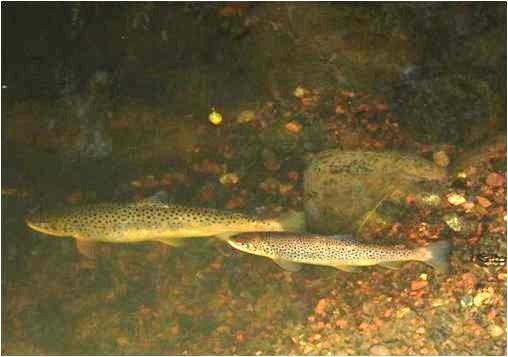
Spawning brown trouts (A.Janatuinen)
Fish are a sign of a healthy river. They can act as a barometer for wider changes in the environment. Fishing and aquaculture are significant industries in Europe. Rivers are not only important for freshwater fish, but sea fish also use our estuaries for reproduction and fish nurseries. Fisheries, in both inland and estuarine waters, are an important consideration when carrying out river restoration.
River Restoration and fisheries:
Fish populations in many European rivers have been put under increasing pressure during the last centuries; rivers have been dammed, polluted with effluents, flows reduced through abstraction, and the structure of the rivers modified. The result is unhealthy fish populations and a poor ecology.
River restoration to reverse the decline
River restoration can help to reverse this decline and restore rivers to a more natural state. The free migration of fish in a river is one major challenge. Some species of fish, such as salmon and eels are well known to carry out major migrations between the sea and freshwater. Less well known are the shorter migrations of freshwater and estuarine species, all of which move to a greater or lesser extent in order to find food, habitat or breeding areas. There are many programs for reviving stocks of fish which migrate. These include removing dams, constructing fish passes and improving the quality of the water.
The reintroduction of salmon to the
Rhine is a real success story. This involved building fish passes in the lower part of the river and restoring habitat in the tributaries to allow the fish to reproduce. Fish can also be a focus for change. For example in Eastern Europe the sturgeon is being used as a flagship species to promote river restoration and to highlight the problems of large hydroelectric dams.
Fisheries management to include measures to restore rivers
Restoring fish populations can be complex and the best results come from an integrated approach to river restoration that considers other aspects such as flood risk, social benefits and wider environmental change. Consideration should include actions such as, improving habitat, removing barriers, managing
invasive fish, improving water quality and quantity and restoring
aquatic vegetation. Local angling groups can play an important part in improving their river. Remember some fish species such as lamprey, bullhead and salmon are important at a European scale and receive special protection.
Artificial hatching and stocking has assisted some species in some rivers, but is often not a sustainable solution where other problems need to be addressed. There is also some evidence that stocking of species like salmon will produce adults with lower viability than naturally produced individuals. Natural reproduction, enabled by removing obstacles and by restoring reproduction habitats, seems to be the best way of managing fish stocks in long term. Conflicts between fishery and hydropower as renewable energy should be solved with the help of catchment restoration and water management plans.